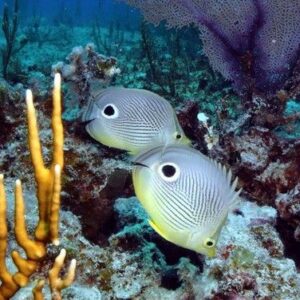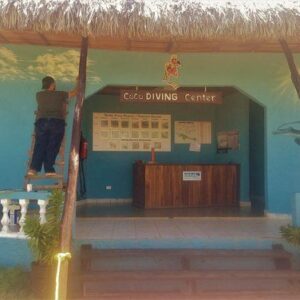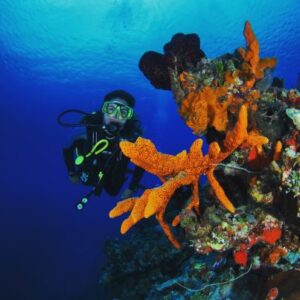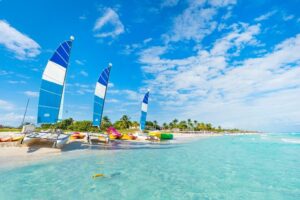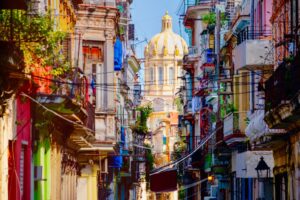
Cuba is considered one of the elite diving destinations in the Caribbean. Divers of all levels will appreciate the diving opportunities in Cuba. The country is known for its unique culture and history which makes it interesting and exciting both above and below the waves. There are wonderful opportunities for the diver and non-diver alike.
Home to the second largest barrier reef system in the world, the underwaters of Cuba include a variety of diving adventures. Cuba’s coral reefs, sea grass beds and mangroves, are amongst the most intact marine ecosystems found in the Caribbean. Divers can expect to see vibrant and colorful coral reefs featuring fifty species of coral and two hundred species of sponge.
Cuba diving is suited for all levels of divers and the warm waters allow divers to visit sites multiple times a day. Divers can experience world-class shark diving. 100 of the world’s 500 shark species are found in Cuban waters. Sharks known in this area include Lemon, Nurse, Bull, Silky, Blacktip, and Caribbean Reef sharks. Encounters with a variety of marine-life such as jewfish, stingrays, green morays, turtles, and saltwater crocodiles, make Cuba diving extraordinary.
GETTING THERE
Air: International air carriers offer regular direct flights from Canada and Europe.
GETTING AROUND
Car Rentals: Rental cars are available, but caution should be taken as the road conditions are substandard, the signage is poor or simply not there at all and the road rules are ambiguous.
Taxi service: yellow taxis are available.
Bicycles: Cuba is a bike-friendly destination.
Train Service: Train services are available but are not reliable.
Boat Service: Two major ferry shuttles operate in Cuba.
GOOD TO KNOW
Country: Cuba
Time Zone: UTC-4 or UTC-5
Primary Language: Spanish but most Cubans can speak English, French, German or Russian.
Currency: Cuban Convertible Pesos is the only currency accepted.
Cell Phone Service: U.S. mobile phones capable of roaming. AT&T, Sprint, Verizon, and T-Mobile currently have roaming agreements with ETECAS and are capable of roaming.
Voltage: 110/230volts AC; 60Hz
Passport and Visa: Passports are required and must be valid for the proposed duration of the stay. Travel, driving and medical insurance policies are required when entering the country.
Hurricane Details: Cuba is subject to hurricanes usually from July to November. On average, Cuba has had one hurricane every two years.
DIVE CONDITIONS
Water Temperature: 72F in December to 84F in July
Water Visibility: 65-130 feet
When to Go: The best time to dive Cuba is between December and April. November – April is the dry season and May – October the rainy season.
Diving Difficulty: Beginner – Advanced
TOP DIVE SITES IN CUBA
Cuba diving is all about warm waters and miles and miles of coastline that includes a healthy ecosystem, wrecks, drop-offs, a labyrinth of over 20 cave systems and UNESCO sites. As the second largest coral reef in the world, Cuba offers divers over 700 species of fish and crustaceans including Goliath Groupers, Napoleon Wrasse, Angel Fish, Rays, Moray Eels, Nudibranchs, Tuna, Lionfish and so much more. The mangroves are home to the majestic manatees and although challenging to find are well worth the effort.
- Jardines de la Reina (Garden of the Queen): Located on the Southern coast, Jardines de la Reina is a chain of 250 corals and mangrove islands in a marine protected reserve established in 1996. This site is accessible by liveaboards only. Only 900 guests are allowed to dive in this area each year. Sharks are one of the main attractions at this dive site and show that this area contains a healthy marine ecosystem. An underwater paradise awaits divers with vertical walls covered in bright sponges, soft black corals, sea fans and huge pillars. Gorgonians and laminar corals are shown through the crevices, canyons, and caves. Divers can swim with crocodiles at this site as well as sharks. At times, 30 or more sharks can be seen circling divers. The sharks are friendly and curious about divers and will come within inches of them.
- Cayo Largo del Sur: Cayo Largo del Sur is a quiet, secluded, and flawless island with over 32 diving spots, many of which are suitable for the beginner diver. This is a great spot for eco-tourists wanting to explore nature both above and below the sea. Thirty walls, tunnels and caves are among a few explorations that wait divers at Cuba’s largest outlying island. Shallow depth reaches 100 feet in most locations which makes this an excellent dive for beginner and intermediate divers. Barracuda, reef sharks and groupers are common species seen here. Cueva del Negro is a favorite diving site with vibrant coral reefs, walls, caves, caverns, swim-throughs, and wrecks. With a beautiful, corralled cave in 25 feet of water, the cave is an excellent place to spot grouper, barracuda, and tuna. Whale sharks, mantas, turtles, eagle rays and large schools of fish such as jacks, grunts, snapper, and tarpons have been spotted here.
- La Habana: La Habana’s history is worth exploring both above and below the water and is home to several interesting wrecks including the Coral Island merchant ship, an old merchant ship encrusted in marine life. The Sanches Barcastegui is another favorite wreck to explore and home to larger sea life. This dive is popular not only for its wrecks but also for its gorgeous coral garden.
- Playa Giron and Playa Larga: Located at the top of the Bay of Pigs, these two beachfront locations offer fantastic shore diving along the reef. The water conditions here are some of the calmest in the Caribbean, which makes it perfect for snorkeling and scuba diving. The diving here is a mix of tunnels, slopes, plateaus, and canals. The canvas is decorated with vibrant hard and soft corals like brain corals and gorgonians. Diving in the deeper waters, divers will exchange the colors for the size of fish with huge barracudas, rays, and eels. The El Jaruco wreck, purposefully sunk in 1994, is home to nurse sharks and is a popular dive destination.
- Varadero: In the North Atlantic, this famous peninsula is as remote as the tiny islands spread out from its tip. With over 20 dive sites just off the shore, divers can spend several days exploring something different each time. Several shipwrecks can be explored as well as unspoiled coral gardens. Fascinating underwater topography can be found, including caverns, caves, cenotes, and some unique rock formations. Varadero is the beach portrayed on most Cuban post cards.
- Santa Lucia: Santa Lucia is protected by one of the largest and best-preserved coral barriers in the tropics. Flocks of pink flamingos make their home in the nearby lagoons. Divers can dive with bull sharks as they make their home in the wreck of Nuevo Mortera. Once a small military steamer, Nuevo Mortera was built in Havana in 1895. It was turned into a cargo ship after its military service. Nuevo Mortera sank in 1905, after crashing into an English cargo ship. The wreck provides a home for the bull sharks and to sea life, like the green moray, schools of snapper, long spine porcupinefish, angelfish, and trunkfish. A few other wrecks can be found here as well as remains of a Spanish fort from the colonial times.
- Santiago de Cuba: As the former capital of Cuba, Santiago de Cuba has it all. The underwater landscape provides divers with tunnels, caverns, walls, and spectacular sea life. The sea floor holds shipwrecks where divers can hand feed enormous groupers. A fleet of five sunken Spanish and two US naval ships from the Spanish-Cuban-American War from 1898 are found here. These ships play a large significance in new and different relations between the three countries involved.
- Maria la Gorda (Fat Mary): Maria la Gorda is a small village that is home to Guanahacabibes National Park. This wall dive offers those who may be intimidated by steep vertical walls an opportunity to dive a wall that slowly slopes in stepped sections. Legend says that Maria la Gorda was sunk due to pirates and said to be buried with treasure. This dive also offers a sunken 18th century ship that provides divers with swim throughs and caverns. Ancla Del Pirata is a massive 2-ton anchor that is a popular attraction in this area. Divers will find many different sponge corals and a variety of tropical fish.
- Punta Frances: Punta Frances is not as well-known as other spots. This national park is home to an amazing underwater world. Small caves, shipwrecks and reefs are the highlight of this dive. Canarreos Reef is one of the most biodiverse reefs in the Caribbean. This world class site is home to 600 species of fish.
- El Farallon (The Cliff) is known as one of the most popular diving sites in Cuba. Massive coral mountains reach tops of 50 feet that are divided into four section tunnels and drop to the seafloor at 100 feet. The tunnels are open and allow light to penetrate through to show the fantastic fish that call this area home. It is a fantastic spot to meet rays, turtles, and reef sharks. Due to the enormous mountain at this site, it can easily be split into several trips.
- Pipin: Located in Jardines De La Reina, Pipin is filled with impressive canyons and caves that run alongside the coast until reaching the drop off where the reef is very colorful and alive. Huge schools of grunts, jacks, and silver tarpon swim in groups of up to fifty. These schools of fish enjoy swimming around and interacting with divers. Turtles, eagle rays and hammerheads enjoy darting towards divers to then disappear in the blue.
- Black Coral I and II: These two dives are the most exciting and considered shark dives. Black Coarl I and II are for those with advanced diver training. Silky sharks and Caribbean reef sharks are always present. The top of the reef reaches 80 feet which slopes down 100 feet to a sandy bottom. Channels run across the reef perpendicular to the coast to a drop off known as the home of more than 30 reef sharks. They love divers and will often come within inches of a diver’s mask. Close to the coral and in the sandy channels, divers will spot sleeping stingrays, parrotfish, big black groupers, and jacks.
An extensive list of adventures and experiences await visitors to Cuba. As a world-class diving destination, it should be on every diver’s bucket list.

